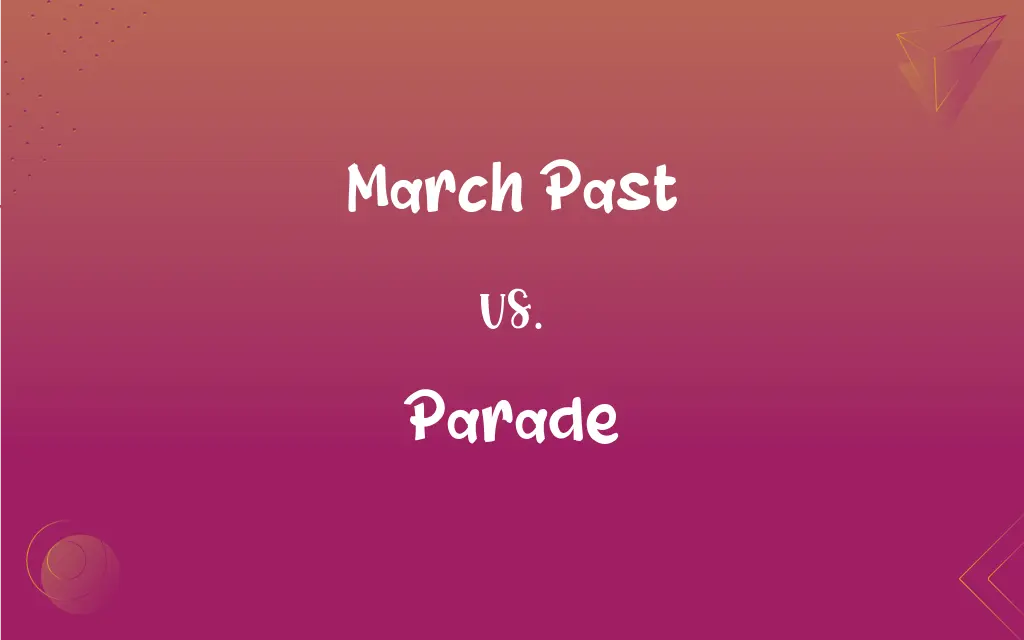March Past vs. Parade: What's the Difference?
Edited by Aimie Carlson || By Janet White || Published on February 28, 2024
A march past is a formal, organized procession, typically of military or other disciplined groups, whereas a parade is a broader, often celebratory procession which can include floats, bands, and diverse participants.

Key Differences
A march past involves uniformed personnel, usually military or school groups, moving in a disciplined manner, often to honor a dignitary or commemorate an event. Parades, however, are more diverse and inclusive, often featuring floats, musical bands, and various community groups.
The march past is characterized by its precision and uniformity, with participants following strict formation and timing. Parades are generally more relaxed, focusing on celebration and public entertainment, with colorful displays and music.
In a march past, the emphasis is on discipline, order, and sometimes showcasing military prowess or organizational discipline. Parades serve as a platform for cultural expression, celebration, and sometimes political messaging.
March pasts are often part of military ceremonies, national days, or school events, requiring rigorous training and rehearsal. Parades are common in festivals, national holidays like Independence Day, and can be spontaneous or well-organized.
Spectators of a march past often observe in silence or formal applause, respecting the solemnity of the event. In contrast, parade spectators are usually more interactive, cheering, and participating in the festive atmosphere.
ADVERTISEMENT
Comparison Chart
Participants
Uniformed personnel, disciplined groups
Diverse groups including floats, bands
Nature
Formal, disciplined
Celebratory, festive
Focus
Precision, order, discipline
Entertainment, cultural expression
Occasions
Military ceremonies, national days
Festivals, national holidays, cultural events
Audience Interaction
Observational, formal applause
Interactive, cheering, festive
ADVERTISEMENT
March Past and Parade Definitions
March Past
A march past is often part of official state functions or commemorative events.
The annual Republic Day celebration includes a march past by armed forces.
Parade
Parades are celebratory events, marking holidays, festivals, or special occasions.
The city's annual Christmas parade attracts thousands of spectators.
March Past
A march past is a formal procession of troops in front of dignitaries or during ceremonial events.
The soldiers' march past on Independence Day was impeccably executed.
Parade
Parades can also have thematic floats, mascots, and performances.
The Halloween parade was a hit with its creative costumes and thematic floats.
March Past
It involves disciplined walking in synchronized steps by military or other uniformed groups.
The cadets’ march past was a display of their training and discipline.
Parade
A parade is a festive procession, often including floats, bands, and diverse participants.
The Thanksgiving Day parade featured magnificent floats and lively music.
March Past
This procession emphasizes uniformity, timing, and precision.
The precision in the march past at the parade ground was admirable.
Parade
Some parades have political or social messaging, aiming to raise awareness on various issues.
The Pride Parade was a vibrant celebration of diversity and a call for equality.
March Past
March pasts are a display of respect, discipline, and often, national pride.
The school children's march past was a tribute to the national heroes.
Parade
They often involve community participation and showcase cultural diversity.
The parade included groups representing different cultural communities in colorful attire.
March Past
A procession or parade, especially of troops being reviewed.
March Past
A military parade past a high-ranking officer or head-of-state
FAQs
What is the primary purpose of a march past?
The primary purpose of a march past is to display discipline, order, and respect during formal events.
Are march pasts common in civilian events?
March pasts are also common in civilian events, especially in schools and national ceremonies.
What is the significance of the marching style in a march past?
The marching style in a march past signifies discipline, unity, and sometimes, tribute to tradition.
Can anyone participate in a parade?
Yes, parades often encourage broad community participation and can include diverse groups.
Can a march past have cultural elements?
A march past can incorporate cultural elements, especially in national or school events.
Is a march past only military in nature?
While commonly military, march pasts can also involve other disciplined groups like school bands or cadets.
What makes a parade festive?
The inclusion of floats, bands, cultural displays, and a celebratory atmosphere makes a parade festive.
How long do parades typically last?
Parades can vary in length but often last a few hours to accommodate the various participating groups.
Are march pasts exclusive to government events?
No, march pasts can also be part of non-governmental events like school sports days and private ceremonies.
Do parades have a specific route?
Yes, parades usually follow a specific route, often through major streets or landmarks in a city.
What is the typical attire for a march past?
Participants in a march past typically wear formal, uniform attire.
What is the role of a parade marshal?
A parade marshal oversees the organization and flow of the parade, ensuring it runs smoothly.
Can parades be themed?
Yes, many parades are themed, especially those marking specific holidays or cultural events.
What types of floats are common in parades?
Floats in parades often depict cultural, historical, festive, or thematic elements.
How does a march past reflect national pride?
March pasts, especially on national days, reflect national pride through the display of flags, uniforms, and disciplined formations.
Are march pasts rehearsed?
March pasts usually require rigorous practice to ensure precision and synchronization.
Can parades be held indoors?
While typically outdoor events, some parades, like smaller community or school parades, can be held indoors.
Is music a part of a march past?
Music, especially marching bands, is often a key component of a march past.
Are parades always related to celebrations?
While mostly celebratory, some parades can also focus on awareness, protest, or remembrance.
Do parades involve spectator participation?
Yes, spectators often actively participate in parades through cheering, dancing, and sometimes joining the procession.
About Author
Written by
Janet WhiteJanet White has been an esteemed writer and blogger for Difference Wiki. Holding a Master's degree in Science and Medical Journalism from the prestigious Boston University, she has consistently demonstrated her expertise and passion for her field. When she's not immersed in her work, Janet relishes her time exercising, delving into a good book, and cherishing moments with friends and family.
Edited by
Aimie CarlsonAimie Carlson, holding a master's degree in English literature, is a fervent English language enthusiast. She lends her writing talents to Difference Wiki, a prominent website that specializes in comparisons, offering readers insightful analyses that both captivate and inform.







































































